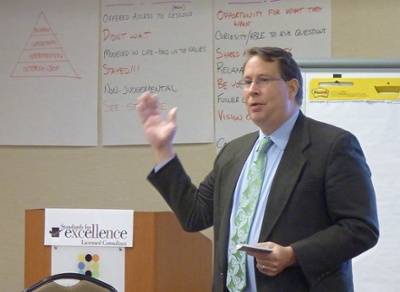
 The following post about nonprofit board effectiveness was written by Standards for Excellence Licensed Consultant Bill Musick and is part of our “Ten Years of Advancing Excellence” blog series, celebrating ten years of the Standards for Excellence Licensed Consultant program. Bill is certified in Healthcare Compliance and Healthcare Privacy Compliance, and certified as a Governance Trainer by BoardSource. He has presented nationally, and is a contributing author to: YOU and Your Nonprofit Board: Advice and Tips from the Field’s Top Practitioners, Researchers, and Provocateurs (Charity Channel Press, June 2013). Bill Musick became a Standards for Excellence Licensed Consultant in 2007.
The following post about nonprofit board effectiveness was written by Standards for Excellence Licensed Consultant Bill Musick and is part of our “Ten Years of Advancing Excellence” blog series, celebrating ten years of the Standards for Excellence Licensed Consultant program. Bill is certified in Healthcare Compliance and Healthcare Privacy Compliance, and certified as a Governance Trainer by BoardSource. He has presented nationally, and is a contributing author to: YOU and Your Nonprofit Board: Advice and Tips from the Field’s Top Practitioners, Researchers, and Provocateurs (Charity Channel Press, June 2013). Bill Musick became a Standards for Excellence Licensed Consultant in 2007.
While Mars Nutrition claims that its M&M’S® “Make Every Occasion Better,” I would say that a key way to Make Every Board Better is to focus on a different set of M&M’s – those that create and sustain a robust culture of integrity. A key goal of the Standards for Excellence Institute is to promote the highest standards of ethics, effectiveness, and accountability in nonprofit organizations. What better way to express this goal than to create a culture where ethical behavior embodies and reinforces the standards espoused by the Institute. The board’s role in developing such a culture falls at the intersection of its responsibility to be effective and its duty of obedience to legal norms of both the corporation and to external law.
Standards for Excellence Guiding Principle II: Leadership, Board, Staff and Volunteers
Nonprofits enjoy the public’s trust, and therefore must comply with a diverse array of legal and regulatory requirements. Organizations should conduct periodic reviews to address regulatory and fiduciary concerns. One of leadership’s fundamental responsibilities is to ensure that the organization governs and operates in an ethical and legal manner. Fostering exemplary conduct is one of the most effective means of developing internal and external trust as well as preventing misconduct. Moreover, to honor the trust that the public has given them, nonprofits have an obligation to go beyond legal requirements and embrace the highest ethical practices.
A Robust Culture of Integrity
One of the basic tenets of behavioral ethics is that it’s rarely the bad apple, but rather situational factors that lead to lapses in ethical behavior. So environment matters. What does a culture look like that reduces the number of risky situations that arise and prepares its staff and managers for those cases where ethical guidance may be gray? Work by the Ethics & Compliance Initiative points to several key traits of organizations with cultures that effectively support ethical practices:
-
Culture that encourages speaking up
-
Employee confidence that peers and supervisors will encourage and support speaking up and taking the ethical path
-
A belief by employees that the organization is fair in its dealings with all stakeholders
-
The formal and informal communication of standards from executive leadership and the board (often referred to as the “Tone at the Top).
We also know that ethical behavior falls on a continuum from more to less ethical; it’s not usually a case of ethical versus unethical. The traits listed above help ensure that an organization operates in the upper end of this continuum.
So what are these magic M&M’s?
The board’s opportunity to develop and support a robust culture of integrity fall into three major categories:
-
Modelling
-
Monitoring
-
Selection
(ok, only two of them begin with M, but in the right order, they do spell MM’S)
Selection
A board has an important opportunity to create the “tone at the top” by recruiting for integrity when it selects a Chief Executive and new board members. If you don’t already include questions similar to the following in your recruitment process, then add them:
-
How would you describe a person of integrity?
-
How can a person in a board or chief executive role convey to staff that ethical behavior is a high priority?
-
What would you do if you observed or heard about something that you thought might cross the line of appropriate ethical behavior?
And don’t stop at recruiting….think about how you can incorporate elements of ethical behavior into your onboarding process, and incorporate indicators of ethical behavior in the board’s assessment of the Chief Executive and in its own self-assessment as well.
Modelling
“If each level in an organization’s hierarchy emulates the one above it, then an organization can never be better than its board.”
Modelling impeccable ethics is the second way that a board helps to build a robust culture of integrity. A few ways to model ethical behavior in the board room include:
-
Acknowledge ethics lapses, and look for situational factors that contributed to them, rather than individuals to blame
-
Strive for transparency and fairness, and rate yourself on whether your decisions and the process for making those decisions would be considered “fair” by various stakeholders
-
Set aside a moment on the board’s agenda to identify examples of moral courage within and outside the organization, and celebrate those – especially the internal examples
-
Demonstrate priority of ethics by participating in ethics and compliance training or by the placement of ethics and compliance on agendas, organizational chart and in corporate communications
Monitoring
We don’t want to believe that there may be ethical lapses occurring in our organizations, and that denial can lead boards to overlook signs and symptoms. Boards that take ethics seriously should ensure that some sort of organizational assessment takes place. It may consist of a regular survey of employees, volunteers and board members that includes the following types of questions:
-
Have you felt pressure to compromise your standards?
-
Have you observed what you perceived as misconduct?
-
If so, did you report the perceived misconduct? If not, what contributed to that decision?
-
Have you observed retaliation for speaking up regarding perceived misconduct?
In Closing….Be Intentional
All of the elements described above require a conscious effort by a board. One way to start the conversation in a board room is to simply ask do we want to be a board that helps to build a robust culture of integrity? Discuss one of the elements above, or ask the board to rate itself in some of these areas, or review a positive or negative example from the organization’s own experience. The intention to make a positive contribution towards enhancing a culture of integrity can be the start of an ongoing journey by a board to examine itself and the organization in order to meet the guiding principle that boards should “ensure that the organization governs and operates in an ethical and legal manner.”



